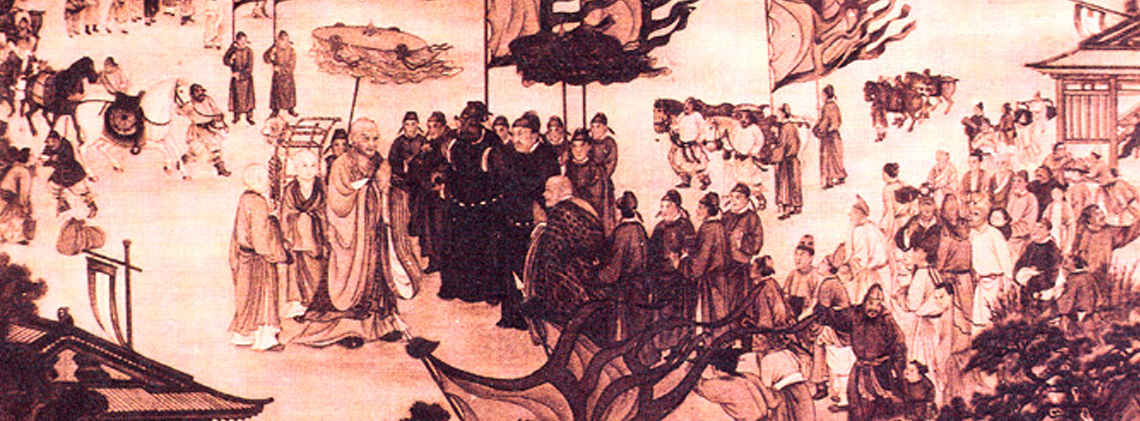
Journey to the West
Splendid
Chi Culture
Topic
Journey to the West
Xiyou ji or Journey to the West (known also as Monkey from a popular English abridgement) is the first supernatural novel of pre-modern Chinese romanticism. It tells the story of the Buddhist monk Xuanzang, usually referred to in the novel as Tang [dynasty] Sanzang, or in translation as Tripitika. The latter is the Sanskrit term for the tripartite Buddhist Canon of sutras whose acquisition was the purpose of this Tang dynasty Zhenguan (627–649) era pilgrimage. Accompanying the monk on this journey to the West during which they must overcome many difficulties are: Sun Wukong, the Monkey King, Monkey, etc.; Zhu Bajie, a half-man, half-pig known as Pigsy, Pig, etc.; Sha Seng, a river-sand demon known as Friar or Monk Sandy, Sandy, Sand, etc.; and Yulong, referred to as Bai Longma: a son of a dragon king, known as the White Dragon Horse. Xiyou ji is one of the four masterpieces of classical Chinese literature.
Xiyou ji is based on a real event—the journey to India to obtain sutras undertaken by the Tang dynasty monk Xuanzang (602–664). Over time the story evolved, with added folkloric characters and expanded mythical settings. Xuanzang’s own account in the Datang xiyu ji (Accounts of the Western Regions during the Great Tang) as well as that found in the Tang dynasty collection of classical short stories called Duyi zhi (Accounts on extraordinary phenomena) share some content with each other and also with Xiyou ji. But it is in the later Song dynasty (960–1279) Datang Sanzang qujing shihua (Ballad narrative of Tang Sanzang seeking Buddhist sutras), that the distinct outline of Xiyou ji (including a monkey character) clearly emerges. In the Yuan dynasty (1271–1368) there appeared Xiyou ji zaju (dramas) and a bit later Xiyou ji pinghua (plain narratives) in which there is further development in the integrity and specificity of the storyline. But the Ming dynasty (1368–1644) novel surpasses them in depth of content and sophisticated presentation. Owing to the low cultural status accorded to fiction (and its creators) during the Ming and in pre-modern China in general, determining the authorship of Xiyou ji which appeared anonymously in 1592 is difficult. In modern times, Lu Xun (among others) speculated that the sixteenth century Ming scholar Wu Cheng’en (ca. 1500–1582) was the author, an opinion shared by many.
Xiyou ji has a somewhat complex structure. It can be divided into one small and one large part. The smaller, shorter part consists of the first seven chapters which describe the legend of Sun Wukong’s (Monkey King) birth and the trouble he causes in the “Three Realms,” that is throughout the universe by his rebellious behavior. Then it turns to the much longer and larger part, the story of the Tang monk Sanzang (Tripitika) and his companions on their eventful westward journey. Between these two parts there is a transitional section further explicating the origin of this sutra-seeking pilgrimage as well as providing some background information on Sanzang. The plot spans time and space as it moves between the “Three Realms”—the Heaven of gods and the Buddha, the Underworld of ghosts and demonic monsters, and the Human world as the characters proceed on their journey and experience eighty-one tribulations. Some of these are inspired by nature, some symbolize society, some allude to historical events, and others explore and reveal the human heart. The novel thus comprehensively reflects pre-modern Chinese society and the problems faced by humankind in that period. Differing from other novels like Sanguo yanyi (Romance of the Three States) and Shuihu zhuan (Water margin), which are episodic narratives; Xiyou ji adapts the structure of a travel journal. Its main characters are Xuanzang and his three disciples; but centering on them, it also depicts gods from different religions and various folkloric monsters and ghosts. The author cleverly combines the natures of humans, animals, and immortals to show the qualities and personalities of the different characters. Sanzang is devoted but weak, Sun Wukong is heroic, Zhu Bajie is voracious and sensual, while Sha Heshang (Sha Seng) is quiet and ascetic. They are all vividly rendered.
Even though this novel predominantly deals with the supernatural, its content has ties to the real social order of its creation. For example, the immortal world with tidy classifications and ordered arrangements is the counterpart of the ruling system in the human world in China at that time. The monstrous beings that dominate and tyrannize are embodiments of similar forces at work in that society. Most importantly, no matter their outward appearance, the characters in the novel all seem to have a human nature, indeed are profoundly human, and this provides a solid foundation for the fusion of imagination and reality which distinguishes this work. Since Xiyou ji was published, it has been subject to many different interpretations. Some focus on its political connotations, while others emphasize its philosophical contents. Still others are interested in exploring its profound insight into the cultural consciousness. The wealth of interpretations reflects the novel’s rich meaning. Among the four masterpieces of classical Chinese literature, with its deep revelation of human nature and experience beyond the limitations of time and space, Xiyou ji shows a higher level of cultural and philosophical value.
Xiyou ji is today broadly circulated domestically and internationally with countless versions. It has been reprinted many times in Korea, Japan, and other East Asian countries. There also exist many translated versions in Western European countries such as France, Germany, Great Britain, and Russia as well as in Canada and the United States, not to mention other regions of the world. It is one of the most popular and widely circulated pre-modern Chinese fictional works.



